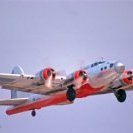Search the Community
Showing results for tags 'alleycat'.
-
Eventually, I've got around to finishing my South African Air Force Spitfire Mk 9 LF. I built this quite some time ago, but couldn't source the correct propeller decals, so it languished in it's polystyrene box until Peter Castle @airscale produced his prop logo decals! Thanks Peter!! This is the Tamiya Spitfire Mk XVIe kit (I'm sure everyone knows how superb the kit is, so I won't go into that), but there were a few modifications I had to make to it in order to get it to the spec that it was in during it's time at the SAAF Museum at AFB Swartkop in Pretoria. This particular aircraft, manufactured in 1945, was flown by by brother-in-law, Maj. James "Jimmy Jet" Feuilherade (Ret) as it's display pilot during his tenure there (1999-2000). It was unfortunately written off during a display accident (15th April 2000), not long after he resigned and emigrated to Australia to take up a position as a flight instructor for BAE Systems. I know he mourned the loss of HIS "British girlfriend" (as my sister used to call it). This build is in homage to Jimmy Jet! Kit - 1/32 Tamiya Spitfire Mk XVIe AM- Barracuda Studios seat, cockpit upgrade (sidewalls, door, throttles, etc), wheels. Alleycat decals (didn't have my Silhouette when I built it, wished I had. The decals were probably old, had quite a few "moments" with them!) Master Barrels And quite a bit of cockpit modification (see the info from James below - all those mods were carried out)) Below are some excerpts from emails James sent me regarding this particular airframe, which helped tremendously with the build. I'm pretty sure he wouldn't mind me sharing some of it... She was actually a rare low back MkIX, powered by a Rolls Royce built Merlin 70 engine. But I hasten to add, there was no difference at all in the MkIX and the MkXVI airframes. The only reason they had the two different Mk numbers was the fact that the American Packard built Merlins were all built using American Imperial size threads bolts and studs. This basically made the Packard Merlins and the RR Merlins incompatible in terms of spares interchangeability. So to avoid huge logistics spares mix ups, they came up with designating all Packard built engine Spitfires, MkXVI’s. The gunsight was removed but I recall she had the rotatable throttle lever, which was normally used with the later gyro sight, so by twisting the throttle handle you could adjust range on the gunsight. An early version of HOTAS I guess! As I recall the seat only had a padded black leather cover, covering the backrest only. I flew it wearing a Harvard parachute which is the same as the WW 2 parachutes. So you sat on the parachute which was held in the seat bucket. The seat was made from Bakelite so was a reddish brown colour. The flare cartridge rack was removed from the front of the seat. The harness was a modern version with medium blue straps as I recall, I think as used on many Spits flying in the UK today. I think it had an olive green lap strap padding aswell. There was a slight difference to the panel in that the U/C indicator lights were moved to the lower RHS of the panel I think due to the newer radios and comms panel that was fitted in the top RHS of the panel. I have a poster with a small insert of the panel, will have to have a look!? Next to the seat below the pilot door was an electrical panel with battery switch lights etc. Things like the morse key and drop tank selector lever were removed. The canopy had the golf club arrangement, good description actually! When closed the canopy was opened from outside by pressing a small button on the tip of the windscreen canopy arch. It is small and very obvious. The bubble top canopy had an operating mechanism on the RHS of the cockpit, set up of covered chains going to the rear and a small winding handle. Flaps are interesting. They are spring loaded up, and extend open against the spring pressure by compressed air. Most Spitfires will slowly bleed compressed air from their systems. Brakes and rad flaps operated also by comp air. So even if you left the flaps down, after a while the pressure would drop and the springs would then snap them closed. However, you always retracted them on the ground after landing as if left down the restrict airflow through the radiators. That is why you hardly ever see a Spitfire pictured with flaps down. Flap selection is either up or down, to 64 deg. So never used for take- off, more of an air brake in a way. Taking off from the carriers for Malta, someone had the ingenious idea of clamping wedges of wood in the flaps against the return spring to hold them open at about 15 deg so as to get some increase in lift for the short take off run. Once airborne, the flaps were selected down then up, dropping the wedges away. The flap hinges pushed up two small panels near the inboard trailing edge of the wing, when flaps down, as an indicator. But not needed, she pitched noticeably nose down when you lowered the flaps in flight. The flaps are always up. It was my party trick if I still had pressure on the ground, and people were nearby I would lower the flaps (little silver lever up on the instrument panel), they would blow down. Then I would select them up, the air pressure blew off through a small orifice at the flap lever, causing a loud hissing noise, startling most people and the springs would then snap the flaps up. The brake differential valve was on the cockpit floor so to speak (no floor as such in the Spitfire) and as you moved the rudder pedals it would direct more air to the one wheel for differential braking. This also caused hissing noises. Of course only heard on ground engine off. As I recall the rad flaps would drop open. One of the tests after start signaled by ground crew, was to close and open the rad flaps to see they were working. Also to select ram air and filter air they would check to see the flap at the front of the carb intake was opening (ram) and closing (filtered). This whole intake assembly is beautifully modelled with the Tamiya Spitfire. The model itself is very lightly weathered. It was always kept in pristine condition by the museum ground crew, and I know for a fact that James used to "baby" it. James wrote an article for Warbird Alley about flying the Spitfire, the link is here if anyone fancies a read. He also sent me an article he had written regarding the SAAF Spitfire - his text is reproduced below. During my posting to the South African Air Force Museum, I had the extreme good fortune to fly the SAAF Museum Spitfire MkIX. This was a low back bubble top variant, normally referred to as a MkXVI. However the MkXVI was fitted with the Packard built Merlin 66 engine, whereas the SAAF Museum aircraft was fitted with a Merlin 70, technically making it a rare low back MkIX. It also had the clipped wing tips, which gave it a superb roll rate at low altitude and was common on Spitfires towards the end of the Second World War, where the main fighter role had become ground attack. The trade off was, a slight loss of turning performance at high altitude, and a slightly higher landing speed. Arguably it also detracted from the beautiful elliptical shape of the wing,. In his book “Fight for the Sky” Douglas Bader described the clipped wingtips as giving the Spitfire “a more workmanlike appearance”. What can one say about flying the iconic Spitfire? So many clichés exist. Such as “It becomes a part of you”, or “You just think of turning, and it does it”. “It feels so right, it becomes an extension of your arms and legs” is another. Phrases you will almost always hear repeated, when veteran Spitfire pilots are interviewed. Having flown the SAAF Museum MkIX, I can say the clichés are indeed true. It is a viceless and easy aircraft to fly. It does exactly what you want it to, the controls are light and powerful. It is docile in the stall and it does “feel right”, like a willing and faithful partner. In combat, it must have been superb. You can hold a max rate turn on the clearly felt light buffet all day, with just a gentle two fingered rearwards pressure on the stick. The rudder is extremely powerful. I once tried to see if I could hold the rudder against the force of full right rudder trim application, which is used for take off. However such is the rudder power, as the speed built to above 100 Kts after take off, despite holding a straight out locked leg, the left rudder pedal merely started to come back and pushing me up the back of the seat, never mind the 5 point harness! Resulting in me having to rapidly wind the trim off. So, no holding that trim force! Your only option, to pitch nose up, throttle back and try to maintain speed at or below 100, to try sort it out. As mentioned with the clipped tips, the roll rate is impressive. As part of my routine, I flew a 2-300Ft AGL level straight roll. In the Spitfire, this is easy, a ghost of an upwards pitch, check, then stick over unloading slightly as you roll to the inverted position. The aircraft rapidly rolls through 360 deg’, the nose remains beautifully balanced rolling about a point on the horizon, with no yaw divergence. The ailerons at air display speeds, are light and powerful. The only tricky area as such with flying the Spitfire is the after landing roll. With no steering on the tail wheel and no slipstream over the rudder throttled back on landing, a bit of dancing on the rudder is required to keep straight, as any sign of a swing needs to be stopped as with that narrow track landing gear, a ground loop could rapidly develop. The unique hand operated compressed air activated brakes work very well. The landing flaps are also air operated, only have two settings, up or down to 64 deg. A marked nose down pitch occurs, when the flaps deploy, pitching the nose down nicely, on base leg turns. A tight base leg needs to be flown, as turning finals too far out will cause the entire airfield to disappear behind that shapely, but long nose, hence the famous Spitfire curved approaches. Of course a big part of the Spitfire mystique is the brilliant 27 litre two stage supercharged V12 Merlin engine, as fitted to the MkIX. The sound of the Merlin in flight is unique and instantly recognised by any aircraft enthusiast worth his/her salt. At low power settings the engine is remarkably quiet. However, as the throttle is opened and plus boost settings are indicated, a wonderful growling noise starts coming up from the rudder pedal area. War emergency boost was in the +15-18 Ft Pounds area as I recall. For take off and most air display routines, it was rare to need much more than 6-8 Pounds boost. Without ammunition, we were technically light. She did have the 0.5 Browning’s and 20mm Cannon still in the wings, left in for Cof G purposes. There are a lot of moving parts in the Merlin, but for all that it is a remarkably reliable engine. When I first heard a Merlin start up, I remember being surprised by the engine sound. The engine does not have the deep “burble” a lot of the big radial aero engines have, as fitted to the Dakota and Harvard with which I was familiar. Rather the Merlin, has a notable high performance, race car type, crackle. At idle, the propeller reduction gear also makes a slight mechanical clattering. On song, the engine note changes to a harsh bellow, amazingly loud during ground runs. In flight, at low power settings, the engine is remarkably quiet. However as you open the throttle and start to get up to plus boost settings, a wonderful deep growling sound starts coming up from behind the rudder pedals. No doubt a lot of modern aircraft fly as well, if not better, than the Spitfire. However, considering the age of it’s design and the massive historic significance it represents, it is certainly one of the world’s iconic aircraft. Long may the precious few still airborne, fly. James Feuilherade Hope you all enjoy! Iain
-
New on the bench, I have wanted to build this for years so when the conversion finally came out I was over the moon.... it's just taken me a while to get one..! Just the one photo for now, will post more later on Unsure what route I'm going for scheme, the world in my oyster as they say.
-
-
I've had the idea to do this conversion ever since Alleycat released their PR XI conversion a few years ago. I figured with the overall PRU blue, it would fit nicely in with this GB. The PCM kit is a great starting point as you're basically building it unarmed. The contents are typical short run but nothing unexpected. The Alleycat conversion set:
-
Hello ! At the moment i try to finish the most old builds possible. This one has not been started a very longtime ago (last spring), but now it's done, too. It the nice Revell G-6 kit, with the Alleycat resin G-12 conversion, the G-6 correcting and detailing set (with propeller, exhausts, ailerons...) and a G-4 set (to get the G-4 engine cowling and early wheels). In fact i dont really know if the aircraft i'm depicting was really based on a G-4, but too bad. Anyway, there is only one picture available as far as know. The build was very fun and without any major difficulties. Fitting the canopies was not very easy, but doable. The fuselage conversion needed a few adjustments but with some patience and some putty, it worked like a charm. The front cockpit is OOB and the rear one is what is inside the Alleycat conversion without any major modification, as it seemed acurate to me (at least with the very few pictures available). The only modification i did were the rear front office (i reshaped the upper instrument box) and the rear bulkhead as this part was not acurate in my opinion, though. Otherwise, i just added two RB seat belts sets, and an Aires gunsight. For the canopies i added some brass sheet rectangle to make the hinges and scratch built the small rods. Regarding the paintjob, the RLM76 was painted with AK paint. It was the first time i used them, and i was a bit surprised, and not really happy with it. I was absolutely unable to spray small details (for the motling) as i can do without any problem with the gunze paints i'm used to. I must be me as many of LSP members here use the AK paint and are very happy with it. For the RLM74 and 75, i used my usual Gunze paints, as the colors seemed better to me, and at least i could control the spray. Every marking were painted with custom masks. The markings for this specific aircraft were included in the Alleycat set, but the 512 was supplied in yellow and black or white and red. The final process was the weathering. I used various AK and Mig washes and filters, and added some black pigments around the exhaust staining and some dust on the belly and wheels. I know my choice for the red lower engine cowling may be a bit surprising and appear weird as it's very unusual in the Luftwaffe schemes. But this profile doesn't seem so incoherent when one changes it in B&W and compares it with the period picture. It may be fictionnal, it may be not. Nobody knows. And it was a training unit, so everything is possible. Anyway, i think these colors are a nice change in the usual LW schemes. To sum up, it was a funny build, sometimes a bit longer (longer than a usual Bf109 build), but very interesting. I really love the look of the 109 with that long greenhouse lookalike canopy. A very nice addition in a Bf109 collection. Here is the link to the WIP thread : http://forum.largescaleplanes.com/index.php?showtopic=61745 Hope you like it ! The final process was the weathering. I used various AK and Mig washes and filters, and added some black pigments around the exhaust staining and some dust on the belly and wheels.
- 32 replies






